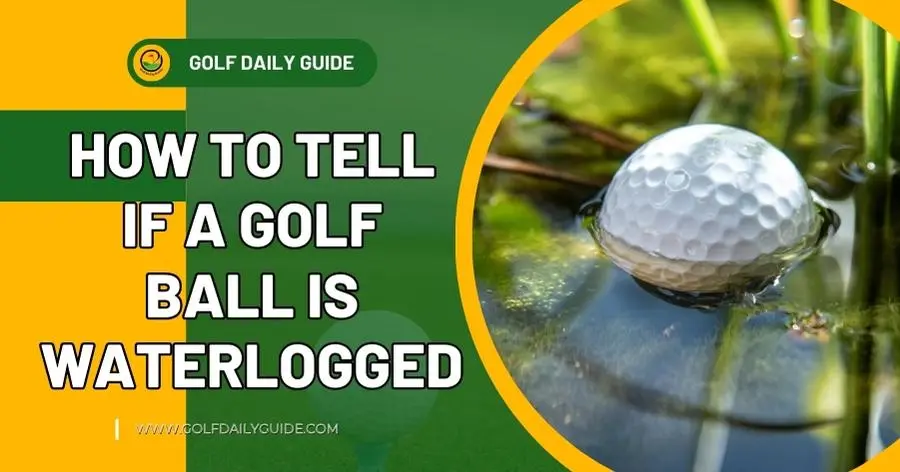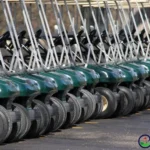To determine if a golf ball is waterlogged, gently sink it in a bucket of water—if it floats, it is waterlogged, while a sinking ball is not. Waterlogged golf balls negatively impact performance due to reduced distance and control.
In addition to the buoyancy test, other signs of water damage include a soft or heavy feel, a faded or discolored appearance, and a musty smell. Do you know How to tell if a golf ball is waterlogged?
It is important to replace waterlogged balls to maintain optimal playability on the course, as they may not achieve the intended shot trajectory or distance.
Assessing the condition of golf balls regularly ensures a consistent and enjoyable golfing experience.
What’s the Issue With Waterlogged Golf Balls?
Golfers know the frustration that comes with hitting a soggy ball. Not only does it affect the ball’s performance, but it can also ruin an otherwise great round.
That’s why it’s important to be able to identify if a golf ball is waterlogged before playing with it. One way to do this is through a visual inspection.
By observing the changes in appearance and surface abnormalities, you can determine whether or not a golf ball has been waterlogged.
In this section, we’ll explore these visual indicators in more detail:
1. Changes In Appearance
The first thing to look for when inspecting a golf ball for waterlogging is any changes in its appearance.
Here are a few visual clues to keep in mind:
Discoloration: A waterlogged golf ball may appear darker or have an inconsistent color compared to a dry ball. Look for any discoloration or splotches on the surface.
Foggy or hazy appearance: Moisture trapped inside the ball can cause it to appear foggy or hazy. If the ball looks cloudy, it’s a sign that it may be waterlogged.
Watermarks: Examine the surface of the golf ball for any visible watermarks or water lines. These can be indicative of water absorption.
2. Surface Abnormalities
In addition to changes in appearance, you should also check for surface abnormalities that may occur when a golf ball is waterlogged.
Here are some common abnormalities to watch out for:
Indentations or cracks: A waterlogged ball may develop indentations or cracks on its surface as a result of the water expanding and contracting inside. Run your fingers along the ball’s surface to feel for any irregularities.
Softness: Gently press your thumb against the ball to assess its firmness. A waterlogged ball will often feel soft or less resilient compared to a dry ball.
Weight: Compare the weight of the potentially waterlogged ball to a known dry ball of the same brand. If it feels significantly heavier, there’s a good chance it has absorbed water.
How to tell if a golf ball is waterlogged?
By performing a visual inspection and looking for changes in appearance and surface abnormalities, you can increase your chances of identifying a waterlogged golf ball.
Remember, it’s always better to err on the side of caution and replace any questionable balls before starting your game.

Now that you know how to inspect a golf ball for waterlogging visually, you can play with confidence and ensure the best performance on the course!
1. Physical Test
One of the easiest and most reliable ways to determine if a golf ball is waterlogged is by performing a physical test.
This test involves two simple steps: squeezing the ball and checking for weight difference. These methods can help you assess whether your golf ball has absorbed water and may affect your performance on the course.
2. Squeezing The Ball
One way to test if a golf ball is waterlogged is by giving it a gentle squeeze. Hold the ball in your hand and apply a little pressure by using your fingers. A waterlogged ball may feel softer and more “squishy” compared to a dry ball. When you squeeze a waterlogged ball, it may have some give and might not spring back to its original shape as quickly as a dry ball would.
3. Checking For Weight Difference
Another method to determine if a golf ball is waterlogged is by comparing its weight to that of a dry ball. Ideally, a golf ball should weigh around 45.93 grams (1.62 ounces). Begin by weighing several dry balls using a digital scale or a golf ball scale.
Take note of their average weight. Next, weigh the suspected waterlogged ball using the same scale. If the ball’s weight is significantly higher than the average weight of the dry balls, it may indicate water absorption.
Pro tip: If you’re on the golf course and suspect that a ball has become waterlogged, you can use this physical test to assess its condition quickly. This allows you to replace the ball and maintain fair play.
By following these physical tests, you can easily determine if a golf ball is waterlogged. Ensuring that your golf balls are in optimal condition will contribute to your performance on the golf course, allowing you to play your best game.
Can Golf Balls Get Waterlogged?
Golfers understand the importance of a golf ball’s optimal performance, and waterlogging can significantly affect its playability.
Performance analysis is crucial for identifying waterlog golf balls, as it impacts distance and ball flight.
Understanding these factors can help golfers make informed decisions on the course.
1. Impact On Distance
A waterlogged golf ball loses its springiness, resulting in decreased distance.
Reduced compression leads to a loss of power upon impact. Decreased carry and roll due to added weight from water absorption.
2. Effect On Ball Flight
Waterlogged golf balls can alter the ball’s flight trajectory. Diminished backspin due to reduced impact force. Inconsistent and erratic trajectory as a result of compromised aerodynamics.
3. Effect On Shot Accuracy
Determining whether a golf ball is waterlogging is crucial for shot accuracy on the course. Check for excessive weight, loss of distance, and a different sound upon impact to ensure optimal performance.
Golfers understand the importance of using a well-maintained golf ball to achieve accurate shots. However, a saturated golf ball can significantly impact shot accuracy.
It is crucial to be able to identify if a golf ball is waterlogging to avoid compromising your performance on the course.
In this article, we will delve into the influence of waterlogged golf balls on shot accuracy and explore how it affects putting and the overall rolling of the ball.
4. Influence On Putting
Putting is a critical aspect of golf, requiring precision and control. When using a waterlogged golf ball, putting becomes challenging due to several factors.
Firstly, the excess moisture within the ball alters its weight distribution, affecting its balance and stability on the putting greens.
The ball may wobble or veer off course, leading to missed putts and frustration. Secondly, the uneven rolling caused by waterlogging impedes the golfer’s ability to read the greens accurately.
The ball may deviate from its intended path, making it difficult to judge the line and speed. These inconsistencies make it hard to execute smooth, precise putting strokes and ultimately hinder shot accuracy.

How Water Affects Golf Balls?
How to tell if a golf ball is waterlogged? The saturated nature of a golf ball results in uneven rolling on the fairway. As the ball moves through the grass, the excess moisture trapped inside disrupts its trajectory, causing it to veer off course.
This erratic movement affects the golfer’s ability to control the direction and distance of their shots. Misjudging the amount of roll or spin due to waterlogging can lead to shots that fall short or veer into hazards.
The lack of consistent ball movement undermines shot accuracy and makes it difficult to execute the intended shot with precision.
To determine if a golf ball is waterlogging, look out for signs such as a heavy feel, discoloration, or visible water seeping out when compress. Additionally, a quick visual inspection may reveal cracks or damage that could indicate water ingress.
Remember to check your golf balls regularly, especially after playing in wet conditions or when retrieving balls from water hazards.
In conclusion, understanding the effect of waterlogging on shot accuracy is crucial for any golfer aiming to maintain a consistent performance on the course.
By recognizing the influence on putting and the uneven rolling caused by waterlogged golf balls, players can make informed decisions about ball selection and ensure their shots remain accurate and controlled.
Damaged or waterlogged balls shall be promptly replaced to optimize performance and enhance the overall golfing experience.
1. Prevention Tips
In order to prevent your golf balls from becoming waterlogged, it is important to follow some key guidelines when it comes to storage.
By implementing these storage guidelines, you can keep your golf balls in optimal condition and avoid any waterlogging issues.
2. Storage Guidelines
Proper storage is crucial to ensure your golf balls stay dry and in top shape.
Here are some essential guidelines to follow:
Store golf balls in a cool, dry place: Choose a location where your golf balls are protect from moisture and excessive heat. This could be a climate-controlled room or a golf bag with compartments that provide ample ventilation.
Avoid storing golf balls in damp environments: Moisture is the main culprit behind waterlogged golf balls. Keep them away from areas such as basements, garages, or any other place prone to high humidity.
Use moisture-absorbing agents: Consider placing silica gel packets in the storage container to help absorb any moisture that may be present. These packets are readily available and can be a game-changer in preventing waterlogging.
Keep golf balls away from water sources: Make sure that your golf balls are not store near sinks, water heaters, or any water sources that could potentially expose them to moisture.
3. Use Of Marking Systems
Having a marking system for your golf balls can be an effective way to prevent waterlogging. By branding or marking your golf balls, you can easily identify them and reduce the risk of mistakenly using waterlogged balls.
Consider the following options:
A. Permanent marker:
Use a permanent marker to write your initials or a unique symbol on each ball. This will help you differentiate your balls from others on the course.
B. Personalized golf balls:
Consider investing in personalized golf balls with your name or logo. Not only will this prevent confusion, but it can also add a touch of personalization to your game.
C. Color-coded system:
Assign different colors to different brands or types of golf balls. This will make it easier for you to spot any waterlogging signs based on the color of the ball.
By following these prevention tips, you can keep your golf balls free from water damage and ensure a better overall performance on the course.
Your Launch Monitor Stats Are Off
How to tell if a golf ball is waterlogged? Evaluating whether a golf ball is waterlogging involves a simple test. Submerge the ball in a bucket of water and watch for air bubbles.
If bubbles appear, the ball has absorbed water and is no longer suitable for play. This method helps golfers ensure the quality of their equipment.
When looking to determine if a golf ball is saturated, seeking professional input can be highly beneficial in ensuring accuracy.
Consulting with experts and utilizing golf ball testing services can provide valuable insights into the condition of the golf ball, helping golfers make informed decisions about their equipment.
Consulting With Experts
Experts in the field of golf equipment can offer valuable guidance in evaluating the waterlogging of golf balls.

With their specialized knowledge and experience, they can provide insightful advice on identifying the signs of water damage and assessing the performance implications.
1. Utilizing Golf Ball Testing Services:
Professional testing services can employ advanced techniques to assess the waterlogging status of golf balls.
By utilizing these services, golfers can gain a comprehensive understanding of the extent of water damage, enabling them to make informed decisions about the usability of their golf balls.
2. Cost Consideration:
To determine if a golf ball is waterlogging, consider its weight and texture. A waterlogged ball will feel heavier and have a soft, soggy texture. It may also have a reduced bounce when dropped.
How Long You Can Leave Golf Balls in Water?
How to tell if a golf ball is waterlogged? Determining whether a golf ball is saturate is an essential skill for golfers. Not only does a waterlogged ball affect performance, but it can also have financial implications.
Understanding the cost consideration of playing with waterlogged golf balls can help you make informed decisions about your golf equipment.
Let’s take a closer look at the impact on expenses and the economic implications associated with waterlogged golf balls.
One of the immediate cost considerations is the need for ball replacement. When a golf ball becomes waterlogged, its performance suffers, resulting in shorter distances and reduced accuracy.
This can lead to a higher number of lost or misplaced shots, increasing the frequency at which golfers need to purchase new balls.
Golfers may find themselves spending more on replacements than necessary if they continue using waterlogged balls without realizing their detrimental effects on their games.
Will Waterlogged Golf Balls Dry Out?
Beyond the cost of replacing waterlogged balls, there are economic implications that golfers should take into account.
Firstly, playing with waterlogged golf balls can significantly impact your overall score. The compromised performance may lead to poorer shot outcomes, ultimately affecting a golfer’s placement in a tournament or league.

This could result in missed opportunities and lower prize winnings. Moreover, prolonged use of waterlogged balls can cause wear and tear to your golf clubs.
When struck, waterlogging balls tend to be heavier and softer, putting extra stress on your clubface. This can lead to faster deterioration of your clubs and potentially shorten their lifespan.
Incurring additional expenses to repair or replace clubs prematurely can add up over time. In addition, using waterlogged balls can affect your reputation among other golfers.
The quality of your shots may be negatively impact, and your playing partners might question your commitment to the sport.
This can undermine your credibility and networking opportunities within the golfing community, which can hinder potential sponsorships or partnerships in the future.
Considering the impact on expenses and economic implications, it becomes clear that identifying and replacing waterlogging golf balls is crucial for both financial and performance reasons.
By regularly checking the condition of your balls and replacing them when necessary, you can maintain a consistent game and save money in the long run.
Remember, even though soaked balls may seem insignificant at first, their negative effects can add up over time, making it imperative to prioritize your equipment’s performance and quality.
Frequently Asked Questions On How To Tell If A Golf Ball Is Waterlogged?
How Can You Tell If A Golf Ball Is Waterlogged?
Waterlogged golf balls will feel heavier, have a softer feel when squeezed, and may have a water stain or discoloration.
What Happens When A Golf Ball Is Waterlogged?
When a golf ball is waterlogged, it loses its initial distance, feel, and performance due to the water affecting its weight and compression.
Are Waterlogged Golf Balls Still Usable?
Waterlogged golf balls may still be usable, but they will not perform as well as dry ones and will have reduced distance and accuracy.
How Does Waterlogging Affect A Golf Ball’s Flight?
Waterlogging affects a golf ball’s flight by reducing its distance and accuracy. The water adds weight and affects the ball’s compression leading to less carry and control.
How Can You Prevent Your Golf Balls From Becoming Waterlogged?
To prevent golf balls from becoming waterlogged, store them in a dry place, avoid playing in wet conditions, and inspect them regularly for signs of water damage.
Related Post
What is an ostrich in golf
How many dimples in a regulation golf ball
Why golf cart cranks but won’t start
How to winterize electric golf cart
What should my golf cart charger read when fully charged
Bottom Line About How to Identify Waterlogged Golf Balls
Knowing how to identify a waterlogged golf ball is essential for maintaining game integrity. By conducting simple tests and understanding the signs, golfers can avoid the negative impact on their game caused by waterlogged balls.
By staying vigilant and informed, players can safeguard the quality of their play and enhance their overall golfing experience.












